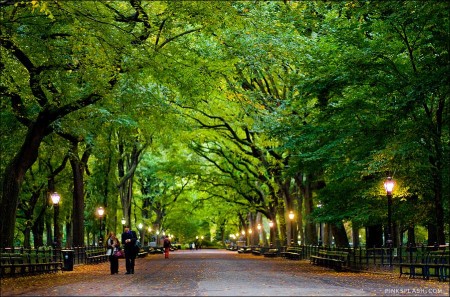Central Park is an urban park in middle-upper Manhattan, within New York City, New York. Central Park is the most visited urban park in the United States as well as one of the most filmed locations in the world.
It was established in 1857 on 778 acres (315 ha) of city-owned land. In 1858, Frederick Law Olmsted and Calvert Vaux, two soon-to-be famed national landscapers and architects, won a design competition to improve and expand the park with a plan they titled the “Greensward Plan”. Construction began the same year and the park’s first area was opened to the public in the winter of 1858. Construction continued during the American Civil War further south, and was expanded to its current size of 843 acres (341 ha) in 1873.
It was designated a National Historic Landmark (listed by the U.S. Department of the Interior and administered by the National Park Service) in 1962. The Park was managed for decades by the New York City Department of Parks and Recreation, and is currently managed by the Central Park Conservancy under contract with the municipal government in a public-private partnership. The Conservancy is a non-profit organization that contributes 75 percent of Central Park’s $65 million annual budget and is responsible for all basic care of the 843-acre park.
Central Park, which has been a National Historic Landmark since 1962, was designed by landscape architect and writer Frederick Law Olmsted and the English architect Calvert Vaux in 1858 after winning a design competition. They also designed Brooklyn’s Prospect Park. Central Park is one of the most famous sightseeing spots in New York. It is bordered on the north by Central Park North, on the south by Central Park South, on the west by Central Park West, and on the east by Fifth Avenue.
Only Fifth Avenue along the park’s eastern border retains its name; the other streets bordering the park (110th Street, 59th Street, and Eighth Avenue, respectively) change names while they are adjacent to the park. The park, with a perimeter of 6.1 miles (9.8 km), was opened on 770 acres (3.1 km2) of city-owned land and was expanded to 843 acres (3.41 km2; 1.317 sq mi). It is 2.5 miles (4 km) long between 59th Street (Central Park South) and 110th Street (Central Park North), and is 0.5 miles (0.8 km) wide between Fifth Avenue and Central Park West.
Central Park also constitutes its own United States census tract, number 143. According to Census 2000, the park’s population is eighteen people, twelve male and six female, with a median age of 38.5 years, and a household size of 2.33, over 3 households.[49] However Central Park officials have rejected the claim of anyone permanently living there. The real estate value of Central Park was estimated by property appraisal firm Miller Samuel to be about $528.8 billion in December 2005.
Central Park’s size and cultural position, similar to London’s Hyde Park and Munich’s Englischer Garten, has served as a model for many urban parks, including San Francisco’s Golden Gate Park, Tokyo’s Ueno Park, and Vancouver’s Stanley Park. The park, which receives approximately 35 million visitors annually, is the most visited urban park in the United States. It is also one of the most filmed locations in the world.
The park is maintained by the Central Park Conservancy, a private, not-for-profit organization that manages the park under a contract with the New York City Department of Parks and Recreation,[56] in which the president of the Conservancy is ex officio Administrator of Central Park. Today, the conservancy employs 80% of maintenance and operations staff in the park. It effectively oversees the work of both the private and public employees under the authority of the Central Park administrator (publicly appointed), who reports to the parks commissioner, conservancy’s president.
As of 2007, the conservancy had invested approximately $450 million in the restoration and management of the park; the organization presently contributes approximately 85% of Central Park’s annual operating budget of over $37 million. The system was functioning so well that in 2006 the conservancy created the Historic Harlem Parks initiative, providing horticultural and maintenance support and mentoring in Morningside Park, St. Nicholas Park, Jackie Robinson Park, and Marcus Garvey Park.
Visits: 190



